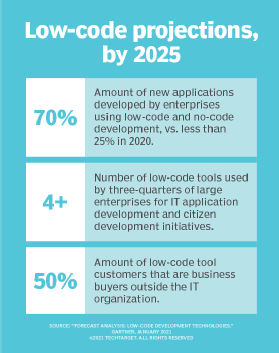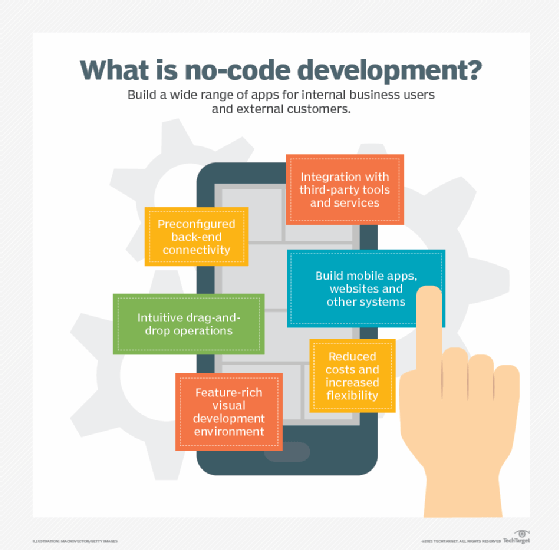For any professional, completing a task on their own can feel infinitely faster than directing someone else how to get it done. No-code and low-code IoT platforms put the ability to build applications into the hands of the users who know what they need but don't have the coding background to make an entire application.
Source: No-code and low-code IoT platforms speed up app development
Organizations use no-code and low-code application builders because developers and users can reach their business needs without programming skills.
If a user employs a no-code application builder, the builder constructs the underlying technical IT infrastructure that the application must interface with. The platform user must write the business logic, such as “how many returns did the company get in July?”
With a low-code application builder, users can write the basic business logic. However, they still must work with IT to integrate the application with the existing IT hardware and software infrastructure.
The demand for more simplified development capabilities has grown, at least in part because of the COVID-19 pandemic. According to a Gartner Original Postress-releases/2021-02-15-gartner-forecasts-worldwide-low-code-development-technologies-market-to-grow-23-percent-in-2021" target="_blank" rel="noreferrer noopener">forecast, researchers predicted the low-code development market will total $13.8 billion in 2021, an increase of 22.6% from 2020.

Advantages and disadvantages of using no-code or low-code platforms
Whether a company uses no-code or low-code application generators, the purpose of automating code during application development is to reduce the time it takes to develop and put applications into production. The hope is that IoT users do not have to depend on IT to make their application and wait in the IT backlog.
Automatic code generators create their code in a highly generic manner. In other words, auto-generated code will work with the general hardware and software environment defined for it. Still, it won't be a custom fit to an enterprise's configured hardware and software environment. Automated code generators are apt to generate more code than is needed. The excess code and instructions consume more storage and processing, and this lack of efficiency can cause longer application runtimes.Organizations use no-code and low-code IoT platforms to solve the business problem of getting applications into production faster.
IoT creates challenges for development platforms
- Gold-Age Movies
- B&W and Color TV Classics
- Hand-Picked Quality Films
- 1930s - 1980s Films
- Big Studio Favorites
- Save favorites list
- Resume watching where you left off
- Search by region, rating, decade
- Nested playlists
- User-friendly interface
Organizations use no-code and low-code IoT platforms to solve the business problem of getting applications into production faster. The bottleneck is IT with its project backlog. Users can deploy IoT applications on their own by using no-code or even low-code generators, but there are several challenges:
- IoT needs rapid runtimes. No-code and low-code tools tend to generate excess code overhead, which can bog down IoT performance. Typically, IoT requires fast application throughput, so no-code or low-code applications for IoT could be too slow.
- IoT is diverse. No-code or low-code platforms may create programming that is too generic to address the plurality and unpredictability of IoT devices. In such a dynamic environment, application developers will likely need IT admins' integration help.
- Out-of-the-box IoT security is inherently weak. Many IoT devices come into an enterprise with weak default security settings that don't meet the minimum security standards. Consequently, IT must assign these devices to the required security settings. Since every IoT device is unique, establishing strong security at the IoT device level is still a largely manual task.
- IoT is infrastructure. No-code and low-code generators abstract program writing away from the details of IT infrastructure so that programmers only need to write the business rules that they want their applications to execute. However, IoT by its very nature is
Organizations can deploy IoT centrally but often deploy at enterprise edges, such as remote plants, field offices, distant utility towers, highways, trucks and cars, or handheld devices in warehouses. Extensive knowledge of IT networks, systems, software, hardware and security are needed to connect all these devices to each other and to the applications and systems that run them. A highly generic solution, such as low-code or no-code, can't address these intricacies of IT infrastructure easily. Instead, it takes IT expertise to integrate IoT devices, systems and databases, enabling all assets to coexist in an end-to-end secure environment.

When does using no-code and low-code generators make sense?
At its topmost level, IoT uses dashboards and straightforward reporting. No-code and low-code tools are ideal for rapidly developing dashboards and summary reports with drill-down capability. These are the reports that users will want for monitoring IoT performance. IoT users can create these top-level reports and dashboards themselves with no-code or low-code platforms and then incorporate them into IoT workflows with a bit of help from IT.
- Material: Striped mini dress made of high-quality...
- Design: Tie-up color block dress features striped...
- Style: Spaghetti strap tank dress, stripe short...
- Occasion: Casual dress is great gift for Mother's...
- Size: Please Refer to the Product Measurement As...
- Fabric: 95% Polyester and 5% Spandex. The fabric...
- Features: floral printed dress, tie dye,...
- Title: tank dress midi dresses for women, summer...
- Occasion: Ideal casual long dress for lying with a...
- Notice: Please refer to our size chart on the last...
- Design:Wrap v neck, sleeveless, cruise party...
- Material:95% Rayon, 5% Spandex. Stretch fabric,...
- Features:Sleeveless, deep V-neck, side pockets,...
- Occasion:Formal Party, Dating, dancing, clubwear,...
- Size: Please Refer to the Product Measurement As...
IoT infrastructure platforms can more easily facilitate no-code and low-code applications. Many low-code software providers offer easy integration with major IoT platforms, including IBM Watson, Microsoft Azure and AWS. Providers also often have low-code offerings expressly designed to integrate effectively with their IoT platforms. If users stay within the bounds of specific platforms and tools, they have a better chance of developing successful low-code IoT applications.
No-code and low-code application generators can be made safe from failure. In cases where users are employing no-code and low-code generators for IoT, IT or even the code generator vendor itself can assist in bulletproofing users from inadvertently creating IoT errors or vulnerabilities. For example, IT can disable certain features in low- and no-code generators that enable users to set their own security. By disabling features in low-code and no-code that could violate corporate governance standards or create other types of errors, organizations can preclude many of the problems that users without IT experience can inadvertently create.






